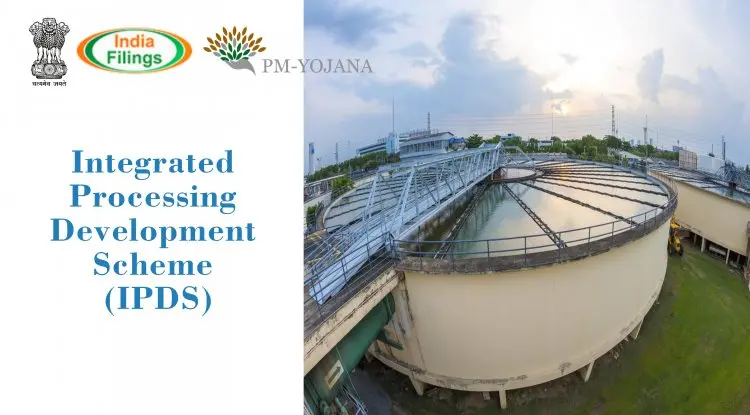Integrated Processing Development Scheme (IPDS)
Integrated Processing Development Scheme (IPDS) was launched to address problems faced by the textile processing industry.

Integrated Processing Development Scheme (IPDS)
Integrated Processing Development Scheme (IPDS) was launched to address problems faced by the textile processing industry.
Integrated Power Development Scheme
A 50 kWp Solar rooftop in Solan, Himachal Pradesh was inaugurated under Integrated Power Development Scheme (IPDS) of the MInistry of Power.
- The project further reinforces the ‘Go Green’ Initiative of the government envisaged in the Urban Distribution scheme.
Key Points
- About IPDS:
- Launch:
- December 2014.
- Nodal Agency:
- Power Finance Corporation Ltd. (PFC), a Navratna Central Public Sector Enterprise (CPSE) under the administrative control of the Ministry of Power.
- Launch:
- Components:
- Strengthening of sub-transmission and distribution networks in the urban areas.
- Metering of distribution transformers / feeders / consumers in the urban areas.
- Schemes for Enterprise Resource Planning (ERP) and IT enablement of the distribution sector.
- ERP helps in integrating the important parts of a business.
- Underground cabling to include additional demand of States and smart metering solution for performing UDAY States and Solar panels on Govt. buildings with net-metering are also permissible under the scheme.
- Objectives
- 24×7 Power supplies for consumers.
- Reduction of AT&C (aggregate technical and commercial) losses.
- Providing access to power to all households.
-
- Eligibility:
- All Power Distribution Companies (Discoms) are eligible for financial assistance under the scheme.
- Funding Pattern:
- GoI (Government of India) Grant: 60% (85% for special category States).
- Additional Grant: 15% (5% for special category States) - linked to achievement of milestones.
- Eligibility:
- Power Sector in India:
- India’s power sector is one of the most diversified in the world. Sources of power generation range from conventional sources such as coal, lignite, natural gas, oil, hydro and nuclear power to viable non-conventional sources such as wind, solar, and agricultural and domestic waste.
- India is the third-largest producer and second-largest consumer of electricity in the world.
- Electricity is a concurrent subject (Seventh Schedule of the Constitution).
- The Ministry of Power is primarily responsible for the development of electrical energy in the country.
- It administers the Electricity Act, 2003 and the Energy Conservation Act, 2001.
- The Government has released its roadmap to achieve 175 GW capacity in renewable energy by 2022, which includes 100 GW of solar power and 60 GW of wind power.
- The Government is preparing a 'rent a roof' policy for supporting its target of generating 40 gigawatts (GW) of power through solar rooftop projects by 2022.
- The Ministry of New and Renewable Energy (MNRE) is the nodal Ministry for all matters relating to new and renewable energy.
- 100% FDI (Foreign Direct Investment) is permitted under automatic route in the power sector.
- Related Government Initiatives:
- Pradhan Mantri Sahaj Bijli Har Ghar Yojana (Saubhagya): To ensure electrification of all willing households in the country in rural as well as urban areas.
- Deendayal Upadhyaya Gram Jyoti Yojana (DDUGJY): The rural electrification scheme provides for (a) separation of agriculture and non-agriculture feeders; (b) strengthening and augmentation of sub-transmission and distribution infrastructure in rural areas including metering at distribution transformers, feeders and consumers end.
- GARV (Grameen Vidyutikaran) App: To monitor transparency in implementation of the electrification schemes, Grameen Vidyut Abhiyanta (GVAs) have been appointed by the government to report progress through the GARV app.
- Ujwal Discom Assurance Yojana (UDAY): For operational and financial turnaround of Discoms.
- ‘4 Es’ in the Revised Tariff Policy: The 4Es include Electricity for all, Efficiency to ensure affordable tariffs, Environment for a sustainable future, Ease of doing business to attract investments and ensure financial viability.
- Achievements:
- Solar tariffs in India have reduced from Rs. 7.36/kWh in FY15 to Rs. 2.63/kWh in FY20.
- As of December 2020, over 36.69 crore LED bulbs, 1.14 crore LED tube lights and 23 lakh energy-efficient fans have been distributed across the country, saving 47.65 billion kWh per year.
- In the first half of November 2020, India's power consumption increased 7.8% to 50.15 billion units (BU), indicating an improvement in economic activity.
- Energy generation from thermal sources stood at 472.90 billion units (BU) in April-September 2020.
- India’s rank jumped to 22 in 2019 from 137 in 2014 on World Bank’s Ease of doing business - "Getting Electricity" ranking.
- As of 28th April, 2018, 100% village electrification was achieved under DDUGJY.
Implementation of IPDS
IPDS was implemented to solve various challenges faced by the textile units. These challenges include non-availability of water for processing and environmental pollution caused by the discharge of untreated effluents. IPDS also aimed at developing processing parks with effluent treatment plants and water supply systems. The implementation of the Integrated Processing of Development Scheme was done during the 12th Five Year Plan through the formation of Special Purpose Vehicles (SPVs). SPV is a corporate body registered under the Companies Act which functions as per the guidelines of the government. It is also responsible for obtaining bank loans and licenses required for the development of processing units in the park.
IPDS focuses majorly on the following three areas:
- Wastewater management
- Adequate and timely supply of water
- Safe treatment of effluents before disposal
-
Agencies involved under IPDS
Apart from Special Purpose Vehicles (SPVs), there are several other agencies that are involved in the implementation of the Integrated Processing Development Scheme. These agencies are:
- Project Management Consultant (PMC): Appointed by the Ministry of textiles, PMC is an advisory panel which provides assistance for the utilisation of funds, monitoring the progress of the project and assessment of proposals.
- Project Scrutiny Committee (PSC): This body is headed by the Joint Secretary to the Ministry of textiles which appraise the proposals for feasibility after submission to PMC.
- Project Approval Committee (PAC): This offers administrative support to the scheme and is headed by the Secretary to the Ministry of Textiles.
- Project Management Agency (PMA): PMA is appointed by the SPVs after the approval of PAC and is responsible for preparation of project plan and other implementation assistance.
- Operation & Maintenance (O&M) agency: It is responsible for the professional maintenance of the assets of SPV for a period of at least 15 years.
The respective state government also had a major role to play in the implementation process. They provided assistance with approvals, suitable land, labour and any other relevant schemes.







